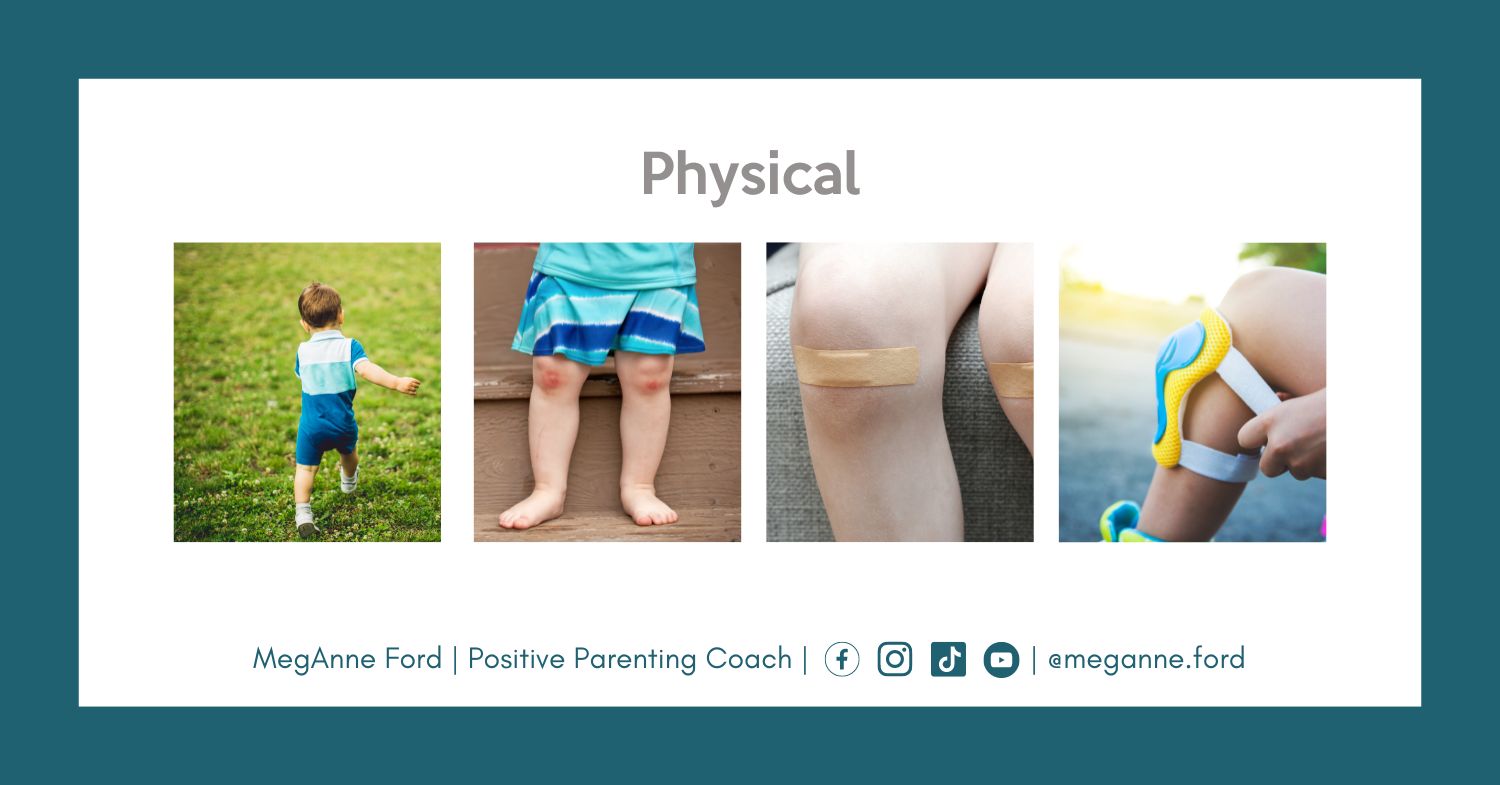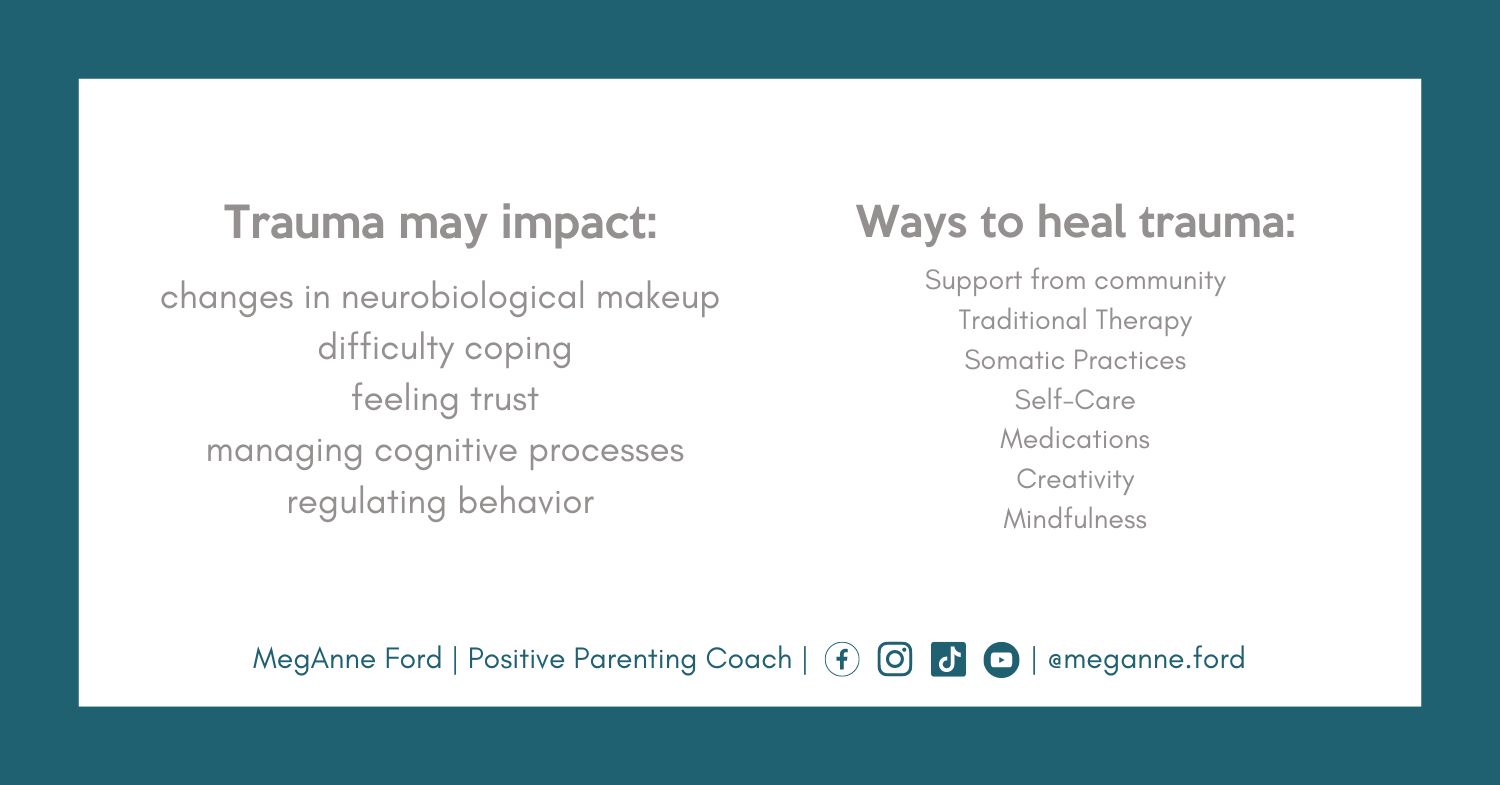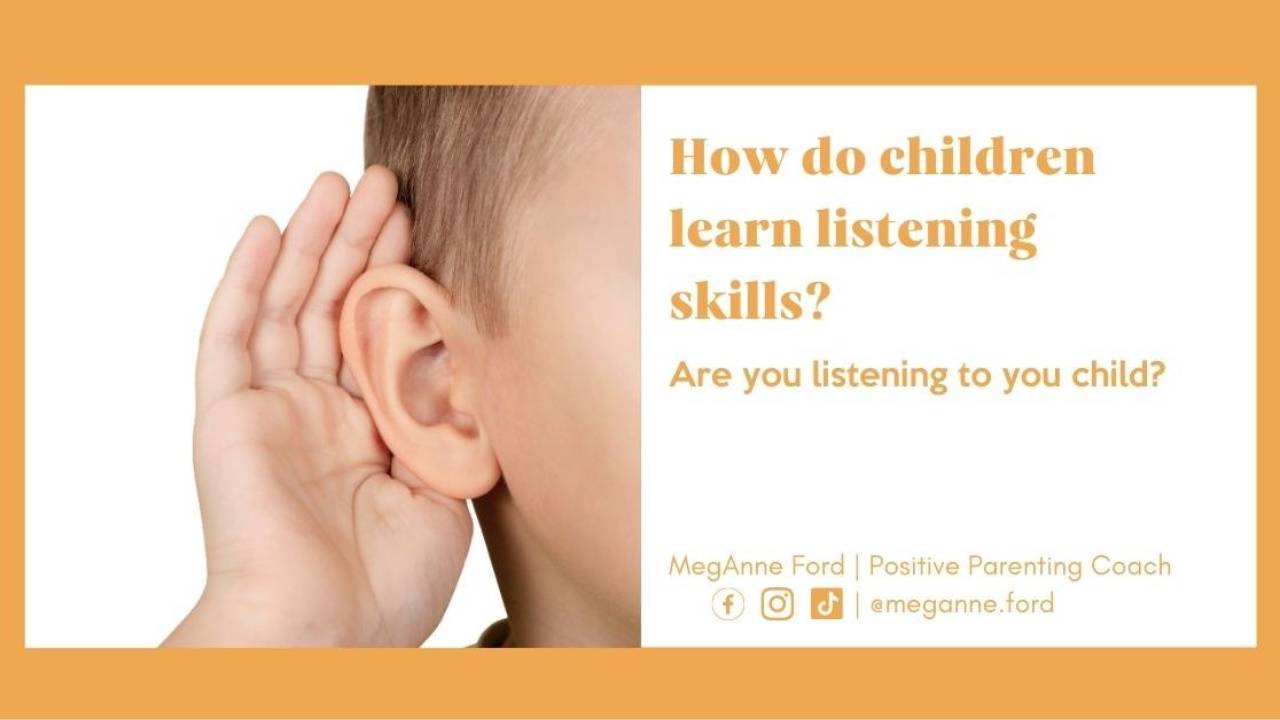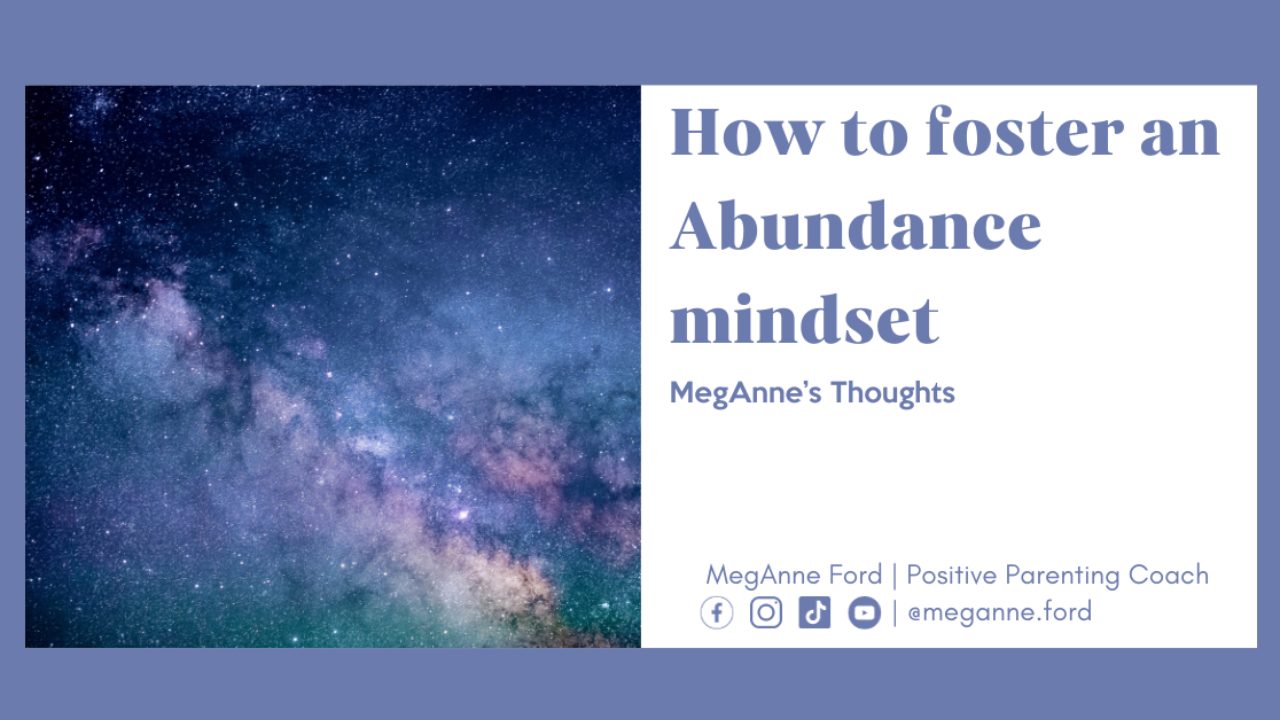
Understanding Childhood Trauma and its Impact
Aug 25, 2023
You can WATCH or LISTEN to this content
Trigger warning: We are working through, from a birds-eye view, what trauma is and its effect on the body. Listen to your body. You could get triggered, which is normal. You are safe here to take a break and come back. Learning about these things can only propel you forward in life.
Meet yourself with love and grace.
The information below serves as a conversation opener and public awareness, NOT a substitution for professional mental health support.
Takeaways
- Healing is not linear; understanding trauma's impact empowers parents to create a safe and supportive environment for their children.
- Childhood trauma affects cognitive, behavioral, and physical development, but nurturing a secure and consistent caregiver can mitigate its lasting impacts.
- By exploring trauma's root causes and effects, parents gain the tools to identify and respond to their children's distress in an empathetic and empowering way.
- Unpacking generational trauma and healing oneself ripples positively through generations, promoting a more conscious and compassionate approach to parenting.
“JUST GET OVER IT!”
That phrase is something that pings for me. I am sure you have heard this message or even said it yourself.
I know that I have in the past heard and used this phrase.
As we dig into this work, often we find we do what was done to us. It does not mean it is right or effective. As we become aware of those tools with negative impact, we can become empowered to release those tools.
I say - ‘Healing is a process and not linear. Healing is not linear or logical, and it’s not something that you can control, rush, or ignore.’
The word trauma used to be a very dirty word for me. It used to scare me, so I put a lot of distance between myself and its meaning. I was protecting myself, but it never absolved the pain.
We can start with little steps about trauma and its impact by first bringing awareness and then moving into education and, finally, practice. We empower ourselves by exposing ourselves to the meaning of trauma, then that word will lose its scariness.
The impact of trauma will persist unless unpacked in an educated manner.
What is Childhood Trauma?

Childhood trauma is best visualized by witnessing someone learning how to walk.
When watching a toddler do their thing, running, walking, balancing, inevitably, they fall, and when they fall, they scrape their knees. It is painful and hurtful. Sometimes, there is blood or little ‘raspberries.’ It is a physical wound.
What do we do with that physical wound?
We bandage the wound. We take care of physical wounds. We wash it and put on anti-biotic cream and a bandage. Maybe we even give it kisses. When the healing process begins, our physical bodies take over, and our knees heal.
Next, we might even prepare and prevent the injury for the next time by putting on knee pads and training wheels or giving a toddler a hand. All of these things are to help protect us as we are learning.
Wounds fascinated me as a child. The scabbing, itching, irritating part of the process, I would often pick at the wound mindlessly, and what did that cause? It caused the wound to extend its healing process. Our bodies must start all over again in healing.
So let's continue and say that we continue to scrape our knees, and on the outside, it looks healed, but the repeated injuries cause chronic knee problems. It starts to throb and brings attention to the fact that we need to attend to something we can’t see.
Maybe it even gets to the point that we need a doctor or a specialist to help.
So with that visual, we can now transfer that knowledge to what is happening in psychological and emotional states, trauma.
Our bodies are designed to heal our hurts, both physical and psychological, emotional and spiritual selves.
Trauma defined by the Substance Abuse and Mental Health Services Administration:
“Individual trauma results from an event, series of events, or set of circumstances that are experienced by an individual as physically or emotionally harmful or life-threatening and that has lasting adverse effects on the individual’s functioning and mental, physical, social, emotional, or spiritual well-being.”
It is like hitting our knees repeatedly, allowing those knees to stay exposed, infected, and continually picked at.

Understanding Child Trauma
The Substance Abuse and Mental Health Services Administration's: The three E's
Events, Experience, Effect
Those three E’s are interlinked and connect in many ways, creating a unique trauma for each individual.
So to say, “Just get over it,” or “It’s not that big of a deal,” or “Come on! It’s not that bad, I could do it, you could do it,” falls short of truly understanding the individual trauma.
Trauma is something that the eye can not see, so we must become curious to find where care is needed. Helping the individual self-access and check in with themselves. Just like we do with physical wounds.
Just like we did with the knee, keep asking and assessing.
What is a traumatic event?
Shock traumas
As a human, sympathy comes easy when dealing with shock traumas, such as a natural disaster or a death in the family. Shock trauma is something that comes on suddenly and causes a lot of pain and suffering. It is easy to sympathize with someone that has suddenly lost their mother. They feel sad and detached. Of course, they would. It is an overwhelming moment.
Developmental Trauma
Developmental traumas are moments that are happening during developmental growth. They happen to us as we are in those developmental stages and create a more clustered, compounded, spread-out impact.
These events, which are both powerful and upsetting, intrude into the daily life of the person. Both can be those shock traumas, those big moments, and those more nuanced moments that happened subtly before we were totally autonomous in our state of being.
Signs and symptoms of traumatic stress
These traumas may impact a person's cognitive, behavioral, or physical abilities.
Think about how comfortable or excited you would be to go roller skating if you continue to fall down and scrape your knees continuously, you might start to have aversions.
You might start to have fears. You might have to start having anxieties. You might have to have a big story about protecting your knees.
Trauma may impact our neurobiological makeup and might influence how we cope with stress. It might become difficult to find trust in another person.
Connecting it back to “What are regulation, co-regulation, dysregulation, and auto-regulation?” Trauma could even impact how we regulate into a calm state and how large our window of tolerance is.
Trauma can dictate what events take us into crisis or shut down. We are experiencing traumas that create emotional inflammation, just as a scab. Picking a scab creates a skin irritation.
Inflammation from trauma can have the same impact on our psychological and emotional bodies, even our spiritual bodies. This comes out as stress. When they are triggered continuously, it compounds, just like scar tissue.

The invite to heal our traumas
Just like our physical wounds, emotional wounds can be healed. Ways to start ‘cleaning’ out the wounds or trauma is with support.
A community of people brought together to understand better that humans come with different traumas. You can join a community like that by taking your first step with The Understanding Series, a way to start understanding yourself and where you are on your parenting journey.
Other ways to heal are through traditional therapies, somatic (yoga, dance, self-care), talk therapies, medications, and different types of modalities that support us in learning and practicing the skills required to navigate and heal trauma. The scar may always be there, but it will not irritate you as often.
I would also invite practicing boundaries by saying no. Practicing patience with yourself is a great self-care practice.
Healing is important, especially for adults. What we don’t consciously heal, we often unconsciously pass on.
The first step of the parenting journey you can start today we explore our inherited toolboxes. We don’t get to control what was passed on to us, and we don’t control to what extent our parents or grandparents chose to heal their trauma so that they may have unconsciously passed it down to us.
We were all children in that space being impacted by our caregivers. We have that shared experience.
This is where the term generational trauma comes up, passing down widely unconscious trauma and tools through the generations until we PAUSE and STOP and decide to heal.
Somewhere it has been said, “When you heal YOU, you heal the generation behind you and in front of you.” That’s very powerful.
We get to choose to heal or not to heal, stay unconscious, stay asleep, stay unaware.
The Impact of Childhood Trauma
The National Institute of Mental Health says, “Childhood trauma is defined as the experience of an event by a child that is emotionally painful or distressful, which often results in lasting mental and physical effects.”
Childhood trauma can impact us because children are still developing and learning from their caregivers. They are learning the tools of regulation. They're learning the tools of co-regulation. They're learning the tools of dysregulation. They, too, can have a narrow tolerance window due to their life's stresses.
There's a big opportunity here as caregivers as someone in the space listening herein this community to work towards becoming safe caregivers, becoming a caregiver who sees them in their experience, becoming a caregiver who helps soothe them in their distressed moments. So that you can become a secure and consistent caregiver, the safer, seen, soothed, and secure a caregiver can be, the lower the impacts of childhood trauma have.
If you would like to take action toward creating a family that is able to navigate daily stresses, subscribe to the Be Kind Coaching mailing list and receive information on steps you can take to take control.

The infographic above gives the communities a choice, empowering them to protect children.
Some key facts from the graphic are
- Childhood Trauma: An event that a child finds overwhelmingly distressing or emotionally painful, often resulting in lasting mental and physical effects
- 2x more likely to develop depression
- 3x more likely to develop anxiety disorders
- Trauma Causes
- Physical Abuse (physical, emotional, sexual)
- Grief (Loss of loved one, friend, teacher, pet)
- Witness/victim of violence
- War and terrorism
- Neglect
- Medical traumas
- Substance misuse
- Mental illness
- Bullying in school
- Separation from loved ones
- Long-term impacts - This means experiencing these stresses and not having a safe, secure caregiver to help regulate and help the child heal.
- Affect the perception of reality
- Wires brain to expect danger
- Triggers fight, fright, freeze, or fawn responses
- Creates relationship problems
- Takes away a sense of safety
- Increases stress hormones flowing through the body
“The initial trauma of young children may go underground, but it will return to haunt us.”
James garabino
That is a powerful quote and why I hold spaces that allow us to become curious about how we prevent childhood trauma and heal our own childhood trauma.
The graphic points out that a traumatized brain is bottom-heavy.
In the blog “The 3 Brain Zones,” we talked about the bottom-up approach. It means that the prefrontal cortex, that green zone, the thinking center, is under-activated.
This could lead to difficulties in concentrating and learning. The child may have an overactive lower brain, meaning the amygdala or that fear center might be over-activated.
This increases the difficulty of feeling safe, calming down, and sleeping.
Trauma can also lead to under-active midbrain and lack of emotional regulation.
An underactive midbrain leads to difficulties managing our emotions. This is why understanding the challenging behavior in front of us invites us, as caregivers, to say, “Hey, instead of adding more stress, instead of adding more struggle, instead of adding more punishments. We can see this behavior as a communication. We can now take a more empowered role.”
To become empowered, the adults must first become aware of their role. This can be scary and overwhelming. This is not a fun topic of parenting.
We can ask ourselves, are we acting as a stressor or support in this moment?
A child comes to you in a distressed state. They are emotionally dysregulated, they are acting poorly, they are acting out, they are crying, they're screaming, they're upset, in those moments, are we as the adult, the person of privilege, the person of power, in that dynamic, are we acting as a stress or adding more?
I will share with you a quote from a favorite TedTalk Quote:
"You know, at first I thought that we marginalized the issue because it doesn't apply to us. That's an issue for those kids in those neighborhoods. Which is weird, because the data doesn't bear that out. The original ACEs study was done in a population that was 70 percent Caucasian, 70 percent college-educated. But then, the more I talked to folks, I'm beginning to think that maybe I had it completely backwards. If I were to ask how many people in this room grew up with a family member who suffered from mental illness, I bet a few hands would go up. And then if I were to ask how many folks had a parent who maybe drank too much, or who really believed that if you spare the rod, you spoil the child, I bet a few more hands would go up. Even in this room, this is an issue that touches many of us, and I am beginning to believe that we marginalize the issue because it does apply to us. Maybe it's easier to see in other zip codes because we don't want to look at it. We'd rather be sick."
Personally, I know there was a long time that I chose to be sick. It was protective because this work was too much, too big even to consider.
What we don't consciously choose to heal, we unconsciously pass on.
When I sat with the above statement, I knew I wanted to reclaim that peace. I wanted to heal. I wanted to show up and do the best I knew I could for the children in my care.
Allow for the ebb and flow
Healing is not linear. It is not always clean, fun, or pretty. It's an ebb and a flow. Healing can be overwhelming sometimes, or at a very slow pace, or doesn't even go anywhere.
But, when we consciously commit to becoming aware of this space of healing, we can consciously choose to meet ourselves exactly where we are.
To consider:
- Where do I feel supported and resourced?
- Where do I feel under-supported and under-resourced?
- What do I feel safe exploring in all of this healing?
We start where it feels safe, we take a bottom-up approach.
We practice where it feels safe so we can begin implementing in spaces that feel less safe.
This is a big topic, and I take it with great honor and privilege to share and have you here reading.
I honor you, and I am so glad you were here.










